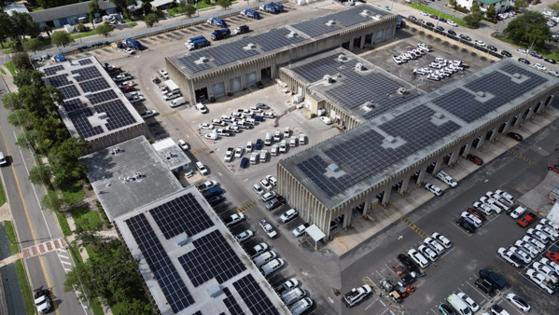Orlando anticipates all-renewable energy buildings by 2027 -- as DOGE probes 'green' spending
Published in News & Features
ORLANDO, Fla. — Orlando is on the verge of powering its municipal buildings entirely by renewable energy, and is on pace to reach that goal three years ahead of schedule.
But the city’s green goals have also drawn a critical eye from Florida’s Department of Governmental Efficiency, or DOGE, which is auditing the city alongside several other local governments across the state.
In his recent State of the City speech, Mayor Buddy Dyer said that the city was on track to run city facilities with solar by early 2027 — an initiative he said boasts environmental and economic benefits.
“Yes, this is about fighting climate change. But it’s also about saving money and increasing operational efficiency,” Dyer said. “It’s an up-front investment that pays for itself over time, and then generates a return in dollars, jobs and other tangible benefits.”
The city council first set the goal in 2017, alongside a larger target of powering the entire city with renewable sources by 2050. Other cities, like Burlington, Vermont, and Aspen, Colorado, have entirely renewable electrical grids, though Dyer has strived to position Orlando as the most sustainable city in the southeast.
The city’s solar investments also continue, with about 10 new systems expected to be added by the end of 2026 on buildings ranging from community centers to fire stations to the city’s fleet and facilities headquarters.
Between now and the third quarter of 2026, that’s about a $4 million investment, said Mike Hess, the city’s director of sustainability, resilience and future-ready.
At the city’s fleet and facilities building — where employees maintain, repair and replace a range of vehicles and equipment like police cars and solid waste trucks — the new solar system will produce more energy than is used there, Hess said.
Solar is a good investment for cities like Orlando because city workers will occupy their buildings for long periods of time, he said. New solar systems are expected to last about 25 years, and should be entirely paid off in 10 years, meaning taxpayers would reap savings for 15 years.
“If we’re installing roughly $4 million in solar projects … 10 years from now, our taxpayers are going to start to see a $400,000 per year savings on our energy bills,” Hess said. “Ten-year paybacks are great for us because we’re going to own our buildings for a long, long time.”
These investments come as NASA confirmed 2024 was the warmest year recorded, which scientists have blamed on carbon dioxide, methane and other greenhouse gases, which trap heat.
Environmental policies, however, have been some of the biggest targets of Florida DOGE, which Gov. Ron DeSantis and CFO Blaise Ingoglia has characterized as looking for waste and inefficiency but has included scouring records for phrases it deems ideologically suspect.
In its letter demanding a slew of records, DOGE asked the city to turn over documents and data about any “Green New Deal” policies related to climate change, carbon reduction, as well as capital and operating expenses of any such programs.
The Green New Deal itself was a 2019 proposal from U.S. Rep Alexandria Ocasio-Cortez, D-N.Y., that did not advance in Congress and has no connection with local environmental initiatives such as Orlando’s.
City staffers leading the city’s green initiatives were also interviewed by DOGE auditors when they visited City Hall last month, an official said.
Despite the increase in solar usage, the Orlando Utilities Commission, which is city-owned, still relies on coal at its Stanton Energy Plant — at least for now. The utility intends to phase out coal and natural gas by 2050 in favor of solar and renewable sources. It announced in 2020 it would stop burning coal there in 2027 and switch to natural gas.
City leaders have also sought to reduce the energy needed to power its facilities by 20% since 2011. The city issued a $17.5 million bond to cover 55 projects across the city, including switching lights to LED, replacing HVAC systems with more energy-efficient models and automating buildings with smart systems to control usage. Such upgrades were done at the Kia Center, City Hall, fire stations, community centers and other facilities.
Dyer said the results were $2.5 million in annual energy savings.
“It’s fiscally responsible as much as it’s environmentally responsible,” he said.
_____
©2025 Orlando Sentinel. Visit orlandosentinel.com. Distributed by Tribune Content Agency, LLC.







Comments